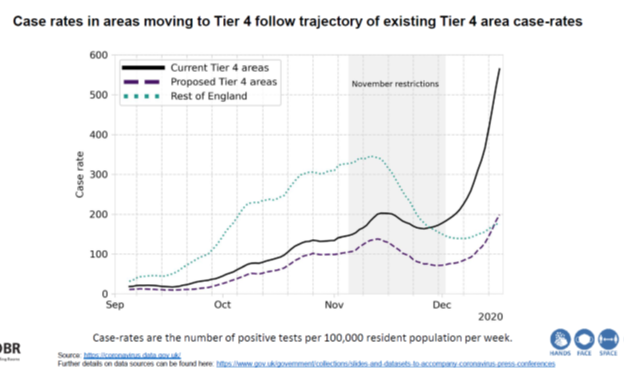
My final thread of the year - a brief review of the current situation and why I think the govt. is right to resist calls for another national lockdown.
Throughout this pandemic I have tried to stress the twin dangers of fear and complacency -
Throughout this pandemic I have tried to stress the twin dangers of fear and complacency -
– excessive fear harms our mental (and overall) health and led to the deaths of thousands in the first wave who were too scared to seek medical help when they needed it. And complacency about the real risks of COVID leads to riskier behavior and increased spread of the virus.
Many recent headlines highlight record numbers of cases and increasing deaths with calls for another national lockdown. And of course it is true that the situation is getting worse but it is important not to panic people by exaggerating the threat but to give the true picture.
i.e. that cases are increasing but they are not at the level they were in March – when we had over 100,000 cases a day in the week leading up to the first lockdown. And that deaths are not increasing yet – and are thankfully still much lower than at the peak of the first wave: 

but they are not falling either & have stabilised at around 400 a day. And more people are dying than usual for this time of year - and the leading cause of death is currently COVID. It also true that the no. of COVID patients in hospital is approaching the first peak nationally
and that in the regions most affected by the new variant (London, South East & East) admissions are increasing rapidly this is already causing elective work to be cancelled – and so harming non-COVID patients.
(Pls my earlier thread for more on impact of new variant.)
(Pls my earlier thread for more on impact of new variant.)

And that is why it is right to continue with the tiered approach with the measures being targeted where admissions/pressure on the NHS is highest. A blanket national lockdown unnecessarily harms those areas with the lowest admissions/pressure- without clear evidence of benefit.
It's also important to see what the impact of the new tiers is first – we saw on previous occasions when infections/admissions/deaths were rising rapidly (in March and Oct.) that people’s behaviour changed – & led to infections falling before lockdowns. conservativehome.com/thecolumnists/…
As I have said many times before, the govt. needs to ensure that measures to deal with COVID are proportionate to the threat and don’t cause more harm than benefit.
And the NHS needs to keep hospital acquired infections down and increase capacity to reduce the pressure.
And the NHS needs to keep hospital acquired infections down and increase capacity to reduce the pressure.
Doctors/nurses/frontline staff will do our best too - but everyone of us can help by being careful when meeting people over Christmas and beyond - particularly with those at higher risk - because COVID is a preventable cause of hospital admission but most other causes are not.
Finally, I hope you all enjoy the Christmas break as best you can (even if, like me, you are in Tier 4) and that, although the coming weeks will be difficult - with the increasing rollout of the vaccine in the New Year - you share my optimism that 2021 will be better than 2020.
• • •
Missing some Tweet in this thread? You can try to
force a refresh






